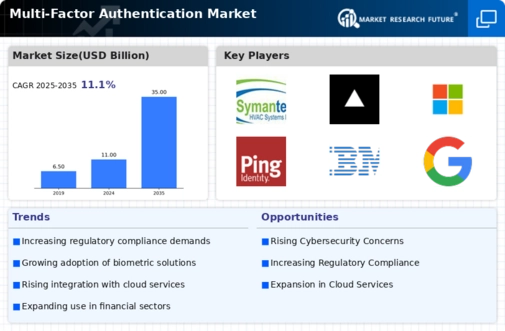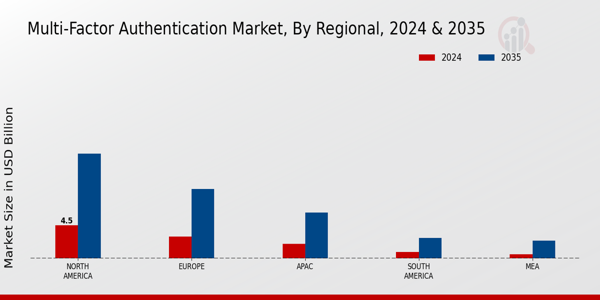Market Growth Projections
The Global Multi-Factor Authentication Market Industry is projected to experience robust growth in the coming years. With a market value of 11 USD Billion anticipated in 2024, the industry is poised for significant expansion. The compound annual growth rate is expected to reach 11.1% from 2025 to 2035, reflecting the increasing demand for enhanced security measures across various sectors. This growth is driven by factors such as rising cybersecurity threats, regulatory compliance requirements, and the adoption of cloud services. As organizations prioritize security, the multi-factor authentication market is likely to evolve, adapting to emerging technologies and user needs.
Rising Cybersecurity Threats
The increasing prevalence of cyber threats is a primary driver for the Global Multi-Factor Authentication Market Industry. Organizations are increasingly targeted by sophisticated cyberattacks, leading to significant financial losses and reputational damage. For instance, the average cost of a data breach is estimated to reach 4.24 million USD in 2024. As a result, businesses are adopting multi-factor authentication solutions to enhance security measures. This trend is expected to contribute to the market's growth, with projections indicating a market value of 11 USD Billion in 2024, reflecting the urgent need for robust security protocols.
Regulatory Compliance Requirements
Governments and regulatory bodies worldwide are imposing stringent compliance requirements, which are propelling the Global Multi-Factor Authentication Market Industry. Regulations such as the General Data Protection Regulation (GDPR) and the Health Insurance Portability and Accountability Act (HIPAA) mandate the implementation of strong authentication measures to protect sensitive data. Organizations must comply with these regulations to avoid hefty fines and legal repercussions. This compliance-driven demand is anticipated to drive the market's growth, with the industry projected to reach 35 USD Billion by 2035, indicating a sustained focus on regulatory adherence.
Growing Awareness of Identity Theft
The rising awareness of identity theft and its consequences is a significant factor driving the Global Multi-Factor Authentication Market Industry. Individuals and organizations are increasingly recognizing the importance of securing personal and sensitive information. High-profile data breaches have heightened public consciousness regarding identity theft, prompting users to seek more secure authentication methods. This awareness is likely to lead to increased investments in multi-factor authentication solutions, as organizations strive to protect their users' identities and maintain trust. Consequently, the market is poised for substantial growth, with an anticipated value of 11 USD Billion in 2024.
Increased Adoption of Cloud Services
The rapid adoption of cloud computing services is significantly influencing the Global Multi-Factor Authentication Market Industry. As businesses migrate to cloud environments, the need for enhanced security measures becomes paramount. Multi-factor authentication serves as a critical layer of security to protect cloud-based applications and data. According to industry reports, over 90 percent of organizations are expected to utilize cloud services by 2025. This shift is likely to drive the market's growth, as organizations seek to safeguard their cloud assets, contributing to a projected compound annual growth rate of 11.1% from 2025 to 2035.
Technological Advancements in Authentication Methods
Technological advancements in authentication methods are shaping the Global Multi-Factor Authentication Market Industry. Innovations such as biometric authentication, mobile authentication, and hardware tokens are enhancing the effectiveness and user experience of multi-factor authentication solutions. These advancements not only improve security but also streamline the authentication process, making it more user-friendly. As organizations seek to implement cutting-edge security measures, the demand for advanced multi-factor authentication technologies is expected to rise. This trend is likely to contribute to the market's growth trajectory, with projections indicating a market value of 35 USD Billion by 2035.

























